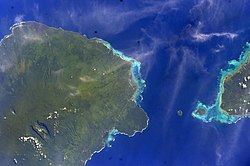Fa'asaleleaga
| Fa'asaleleaga | |
|---|---|
| Basic data | |
| Country | Samoa |
| Capital | Safotulafai |
| ISO 3166-2 | WS-FA |
| NASA satellite photo of the eastern half of Savai'i with the islands of Apolima and Manono and the western tip of Upolus | |
Coordinates: 13 ° 40 ′ S , 172 ° 15 ′ W
Faʻasaleleaga is a political district (itūmālō; electoral district) of Samoa on the east coast of the island of Savaiʻi . In 2016, 13,566 inhabitants were counted.
The main town is Safotulafai , where the chiefs and advisers meet in Fuifatu malae . Safotulafai was also the center of the Mau-a-Pule movement against colonial rule. From this the national Mau-a-Pule movement developed and finally Samoa gained its political independence in 1962. Safotulafai also has close ties with Saleʻaula , the capital of the Gagaʻemauga district .

Faʻasaleleaga holds important Malietoa titles and maintains political alliances with the Tuamasaga district on Upolu . Safotulafai is asked by Malie (Tuamasaga) together with Manono ( Aiga-i-le-Tai ) every time the election of a Malietoa (chief) comes up.
Another important village in the district is Sapapaliʻi , where John Williams went ashore in 1830. He was the first Christian missionary to bring Christianity to Samoa. The Malietoa Vaiinupo received Williams. Sapapaliʻi became the second chief seat of a Malietoa in 1750 when the Malietoa Tiʻa moved there.
In the 20th century Salelologa became the economic capital. The Salelologa wharf (Salelologa wharf) is the ferry pier for island travelers between Savaiʻi and the port of Mulifanua on Upolu.
Maota Airport is the island's main airfield, just a few kilometers south of Salelologa. The village of Tuasivi , north of Salelologa, is a government center ( Malo ) with a district hospital, courthouse, police station and post office.
The tiny islets Asi ( ⊙ ) and Avalua ( ⊙ ) are located off the coast .
Personalities
- Gatoloaifaana Amataga Alesana-Gidlow , the former Minister of Health (2006-2011), was a member of the electoral constituency Faʻasaleleaga No. 1.
Individual evidence
- ↑ citypopulation.de .
- ^ Trudy Ring, Robert M. Salkin, Paul E Schellinger, Sharon La Boda: International Dictionary of Historic Places: Asia and Oceania. : 726.


